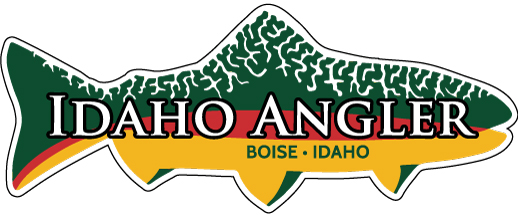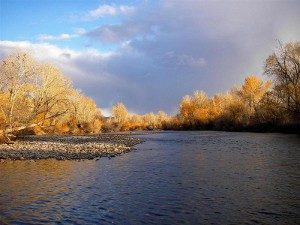
FISH IDAHO
We are very fortunate to have an abundance of rivers, streams, lakes, and reservoirs in Idaho. Depending on how far you would like to drive, the area in and around Boise has fishing that will please even the most discerning anglers. If you are willing to be a little more adventurous, and have more time to travel, Idaho offers some of the finest fishing opportunities you will find anywhere in the country. Exceptional tailwaters, high alpine lakes, high desert reservoirs, and world famous spring creeks; we have it all. Depending on the time of year, you can fish for bass, trout, steelhead, carp, panfish, etc. If you are planning on fishing in Idaho, you can obtain license info from Idaho Fish and Game, or by calling the shop.
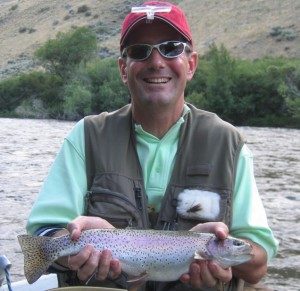
The South Fork of the Boise, below Anderson Ranch Dam and about 1½ hours from Boise, is Southern Idaho’s premier blue-ribbon fishery for wild rainbow trout. The “SFB” is an exceptional tailwater fishery with many fish in the 12-16″ range, good numbers of fish to 20″, and enough reports every season of fish 25″ and bigger to excite even experienced anglers.
Mid-summer usually bring lower flows (~ 600 cfs), excellent wade fishing, and the South Fork’s unique midday Pink Albert hatch, followed by evening flav and caddis hatches. Late-summer and fall fishing finds the river at 300 cfs where it stays until spring. Early fall fishing focuses on hoppers, ants, beetles, and large crane flies, while cooler fall weather reduces fishing pressure on the river and brings out the Blue-wing olive hatches on cloudy days. Trout season closes at the end of November. Winter fishing regulations focus on whitefish with catch-and-release fishing for trout using midges and winter stonefly nymphs. The river closes to all fishing at the end of March to protect the wild trout during their spawning season.
The trout season on the South Fork opens Memorial Day and usually starts fishing well by mid-June with the start of the salmonfly, Golden stonefly, and early-season Caddis hatches. Early summer flows usually range from 1600 to 3000 cfs, a good range for floating in drift boats and rafts, but a difficult range for wading. Flows typically remain high until mid- to late-summer depending upon snow pack and downstream irrigation needs. Historically, September begins the wading season after the river has dropped below 1000 cfs, the preferred range being around 600 cfs. Winter flows are usually around 300 cfs.
The Upper South Fork of the Boise River, above the dam, is a freestone stream that can hold its own at certain times of the year. Like the middle fork and the north fork, it can be a great place to go throw attractor patterns early in the season. It has many of the same hatches and also holds rainbows, whitefish, and bull trout. Kokanee also run up out of the reservoir in the fall. It has two smaller tributaries, Little and Big Smoky Creeks, which can also offer good early season fishing, but they also get increasingly challenging as the flows decrease into late summer and early fall.
The Boise River runs right through the center of Boise and provides one of the city’s most treasured recreational venues. A series of beautiful public parks parallel the river and are linked by the 26-mile long Boise River Greenbelt system. The river and greenbelt provide year round recreational opportunities that include rafting, walking, running, bicycling, and fishing.
The Boise River through town is a tailwater fishery that provides nearby angling opportunities to residents and visitors alike. Sections of the river are managed with special regulations to ensure quality fishing for rainbows, browns, and whitefish.
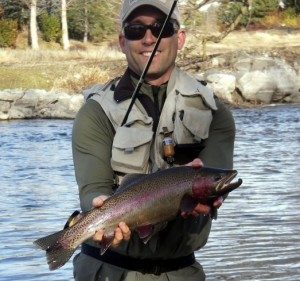 Popular areas (from the eastside to the westside of town) include Barber Park, the University stretch between Broadway and Capitol Boulevards, and Eagle Island. Rainbows dominate on the eastside, while numbers of brown trout increase as you move west, and as the river temperature warms.
Popular areas (from the eastside to the westside of town) include Barber Park, the University stretch between Broadway and Capitol Boulevards, and Eagle Island. Rainbows dominate on the eastside, while numbers of brown trout increase as you move west, and as the river temperature warms.
We also utilize the river in the downtown park sections for teaching our advanced and Spey Casting classes.
Suggested Flies: Bead head nymphs, caddis larva, caddis dries, hoppers, woolly buggers.
 The Boise River, that we see flowing here in town, is formed by the confluence of two forks above Arrowrock and Lucky Peak Reservoirs; the North Fork of the Boise River (approx. 50 miles long) and the Middle Fork of the Boise River (approx. 52 miles long). The South Fork of the Boise River may get all of the attention, but these smaller freestone streams are a couple of gems in their own right. Accessible via Middle Fork Road, towards the old mining town of Atlanta, and several roads outside of Idaho City, these rivers are only about 1.5 – 2.5 hours away from Boise, depending on road conditions.
The Boise River, that we see flowing here in town, is formed by the confluence of two forks above Arrowrock and Lucky Peak Reservoirs; the North Fork of the Boise River (approx. 50 miles long) and the Middle Fork of the Boise River (approx. 52 miles long). The South Fork of the Boise River may get all of the attention, but these smaller freestone streams are a couple of gems in their own right. Accessible via Middle Fork Road, towards the old mining town of Atlanta, and several roads outside of Idaho City, these rivers are only about 1.5 – 2.5 hours away from Boise, depending on road conditions.
The roads to these beautiful streams pass through forests of Ponderosa Pines and Douglas Fir, interspersed with lush river bottoms, meadows, granite outcroppings, and sections of steep canyon walls. These two rivers provide countless miles of pocket water, riffles, and pools. Anglers fishing these waters have an opportunity to catch a variety of wild trout, including Rainbows, Cutthroat, Whitefish, and Bull Trout. The rivers are open all year and there are a good variety of seasonal bugs, including stoneflies, mayflies, caddis, and even the occasional salmonfly. Basic attractor-type fly patterns and terrestrials, such as beetle, ants and grasshoppers, tend to work well in the summer, while in the spring and early fall many fisherman find that the streamer fishing can be very productive. There are also a number of smaller tributaries that can afford some good fishing when the water levels are “right”.
The roads into these areas can be “questionable” in the spring and late fall, so it’s always a good idea to check with the local ranger district before heading out. Locals will also tell you that the journey into these streams can sometimes be downright bone jarring. It usually helps to have a good vehicle, with good shocks, and perhaps even 4-wheel drive. The campgrounds can get busy during the summer, but most of the time it is well worth the drive and there is usually plenty of water to fish. The Upper Boise River Basin is a beautiful place to explore and we are lucky to have it as another fine resource for our local and visiting anglers.
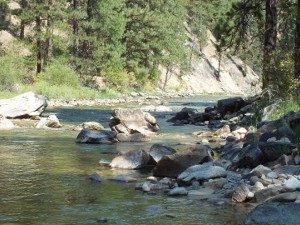
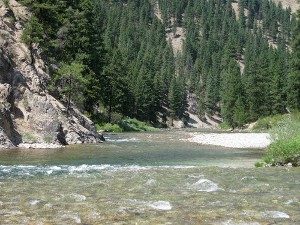
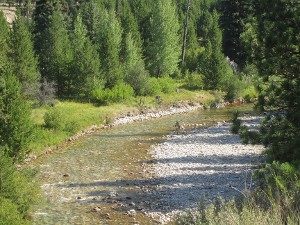
The Owyhee River, a tailwater fishery below Owyhee Dam out of Adrian, Oregon, is home to one of the most incredible brown trout fisheries in the lower 48 states. Fish here average 17″, with fish to 24″ common.
Brown trout can be very active risers and often focus on midges in the Owyhee tail water fishery. Midges are available on the Owyhee throughout the year and many times, tiny subsurface midges will be the target of choice over the larger bug of the day for these big brutes.
Midges notwithstanding, this river boasts an impressive smorgasbord of insect life. Pale Morning Duns are a close second to the midge in importance. Beginning in late May, their emergence sparks some of the most exciting fishing on the Owyhee. Emerger patterns will outfish most other types of patterns used to imitate these pale yellow mayflies.
Callibaetis begin emerging in the spring and continue sporadically into the fall. Often the largest mayfly on the surface, they can entice big fish into gentle sipping rises in slower stretches of the river.
Blue Winged Olives are often seen throughout the summer. Their summer hatch cycle ends with the Tiny Western Olives in a size 24, which can be a difficult mayfly to imitate, but richly rewarding when the fish are on them.
Fall brings an interesting mix of bugs and Mahogany Duns, Callibaetis, Baetis, Caddis, and terrestrials can all be on the river at the same time. Matching the hatch becomes maddening, with so many rising fish and so many bugs. Stepping back and just watching at these times can bring a smile to the anglers face.
Winter can also be a great time to fish the Owyhee. Less people and still good action on midges can make for perfect days in winter sunshine.
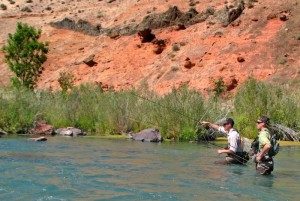
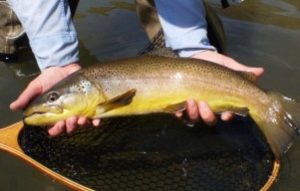
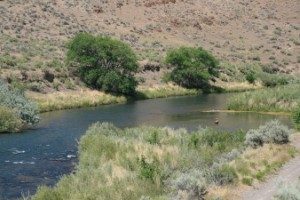
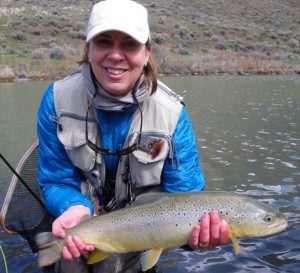
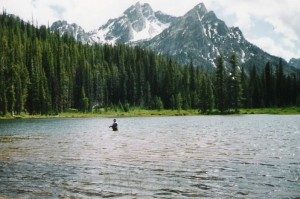 SAWTOOTH MOUNTAIN AREA
SAWTOOTH MOUNTAIN AREA
In many ways, the Sawtooth Mountains and surrounding central Idaho country are the heart of Idaho both literally and figuratively. The Salmon River originates in the Sawtooth Valley above Stanley, while the headwaters of the fabled Middle Fork of the Salmon lie on the northwest edge of the Sawtooth Mountains. This is Idaho at its most spectacular.
Fishing in the Sawtooth country has three distinct seasons: steelhead fishing in the spring, rainbow and cutthroat fishing on the rivers and tributaries in the summer, and a high mountain lakes in late summer for native westslope cutthroat, introduced rainbow, and in certain lakes, Golden trout, and grayling.
The area offers many different fishing opportunities, stunning scenery, and a wide array of camping and hiking sites. Motels and restaurants are found in Stanley and Challis. Major fishing locations and opportunities are described below.
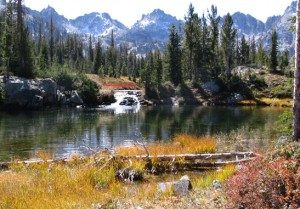 VALLEY CREEK
VALLEY CREEK
Valley Creek meanders through a scenic valley northwest of Stanley (along Hwy 21) that offers spectacular views of the Sawtooth Mountains and good fishing for rainbows and cutthroats with brook trout in the upper reaches. Valley Creek joins the Main Salmon River between Upper and Lower Stanley. Stream flows are usually high until the end of June, after which, dry fly fishing is good with Royal Humpies and Wulffs. Regulations require that all native cutthroat trout must be released.
 MIDDLE FORK OF THE SALMON
MIDDLE FORK OF THE SALMON
This world-renowned river is home to a healthy and thriving native westslope cutthroat trout population that provides great angling from July through September. The Middle Fork lies in a fairly steep canyon and transects the largest wilderness area in the lower 48 states. It is most often accessed by rafters floating the 100-mile stretch from Dagger Falls to the confluence with the Main Salmon. Once the river drops from its spring flows (late June) the fishing can be exceptional, as cutthroat rise readily to attractor dries such as Stimulators, Royal Wulffs, and Royal Trudes. By late summer (end of August), cutthroat migrate into the lower portion of the Middle Fork and into the Main Salmon. Access the Middle Fork of the Salmon at Dagger Falls (the only road access) off Hwy 21 northwest of Stanley.
Suggested Flies: #6-10 Stimulators – Yellow and Orange, Deer hair grasshoppers in #8, Double Humpies in #8 & 10, and #8 Beanie Babies.
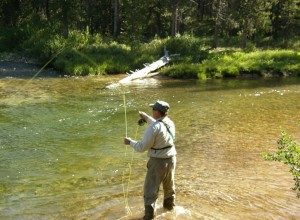 MARSH AND BEAR VALLEY CREEKS
MARSH AND BEAR VALLEY CREEKS
Marsh Creek and Bear Valley Creeks join to form the Middle Fork of the Salmon. Both creeks are fairly easy to access from a vehicle and both provide brook trout fishing in the upper reaches, and good early-season cutthroat fishing in the lower reaches. The best fishing in these streams is in late June and early July: by August, most of the cutthroats have migrated down into the Middle Fork.
Access is off Idaho 21 in the Sawtooth National Recreation Area 2-3 hours from Boise.
Suggested Flies: Stimulators, Ants, Beetles, Wulffs, Adams and mayfly nymphs.
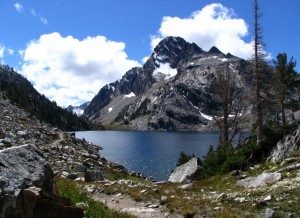 HIGH MOUNTAIN LAKES
HIGH MOUNTAIN LAKES
The Sawtooth area is blessed with a wide variety of high mountain lakes that offer exceptional fishing in a truly stunning landscape. Fishing high mountain lakes in central Idaho in late summer takes you into a pristine environment where the mountain peaks watch over you as you cast to rising trout. The lakes contain a wide variety of trout, including native Westslope Cutthroat, Rainbow, Golden, and Brook Trout. A few lakes can be accessed by vehicle, but most require hiking. As always, the harder you are willing to work, the greater the rewards. Solitude, scenery, and willing trout await!
Perhaps one of the most famous spring creeks in the west, Silver Creek is the destination of thousands of fly fisherman each year. From the early season ‘easy’ fishing to the most challenging fall fishing, Silver Creek will test the skill level of all who ply its crystal clear waters.
Silver Creek lies in the southern end of the Big Wood River valley about 2½ hours east of Boise. The portion of Silver Creek above the Highway 93 Bridge is open from Memorial Day through November 30th. Above Highway 20 is Silver Creek’s most famous stretch. It includes the Nature Conservancy’s Silver Creek Preserve, considered to be the holy water of the creek.
Pale Morning Duns start the season here and continue through most of the season. As is true with most mayfly cycles, first of the season bugs will be larger and get smaller as the season continues.
The impressive Brown Drake hatch begins as early as late May on the creek. Point of Rocks (north of Highway 20) is the area of h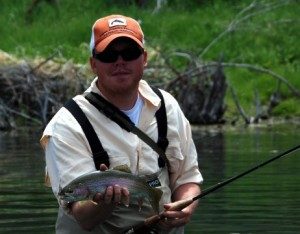 eaviest emergence, but the preserve water also experiences the emergence of this size 10 mayfly, exciting both fish and fly fisherman. All stages of this big mayfly are worthy of imitation.
eaviest emergence, but the preserve water also experiences the emergence of this size 10 mayfly, exciting both fish and fly fisherman. All stages of this big mayfly are worthy of imitation.
Callibaetis and baetis begin hatching in June, followed by the famous trico hatch in late July. The angler that wants some explosive action on a bigger fly will find fishing an adult Damsel in late June through the warm days of August to be exciting fun. Casting up to weed beds where Damsels are landing can be more than the pickiest of trout can handle. Mahogany Duns are important in September and October during the heaver baetis hatches of fall. Terrestrials such as grasshoppers, beetles and ants can produce great results from mid summer to the first freezes of fall.
For the non-fisherman, Silver Creek Preserve is a wonderful place. Miles of hiking trails afford opportunities to view the ample wildlife of this area. Deer, Coyotes, the occasional Moose and hundreds of species of birds can be found within the preserve boundary.
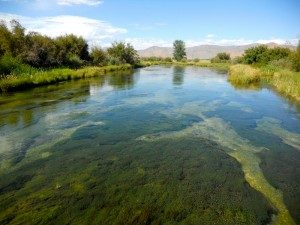
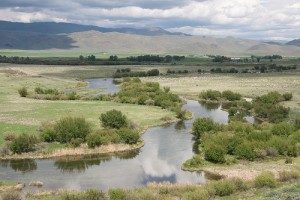
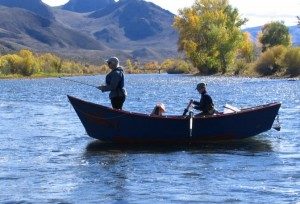 The Upper Salmon River, from Stanley downstream to Challis, has two distinct fisheries. Steelhead move into the river around March 15 as water temps begin to rise. Fishing is primarily walk-and-wade, angling to visible fish. Fish are beginning to spawn around this time, but remain very aggressive through the season, which ends in late April. A Sawtooth National Recreation permit is required along with a Steelhead permit. This is a favorite area of local anglers as the fishing is usually consistent and access easy.
The Upper Salmon River, from Stanley downstream to Challis, has two distinct fisheries. Steelhead move into the river around March 15 as water temps begin to rise. Fishing is primarily walk-and-wade, angling to visible fish. Fish are beginning to spawn around this time, but remain very aggressive through the season, which ends in late April. A Sawtooth National Recreation permit is required along with a Steelhead permit. This is a favorite area of local anglers as the fishing is usually consistent and access easy.
Access is via Highway 75, Northeast from Stanley. The road follows the river the entire stretch, making access easy.
Suggested Flies: Dr. Seuss, Boss, Egg-Sucking Leeches and Crystal Egg Patterns.
The second fishery on the Upper Salmon is a summer fishery for rainbow and native cutthroat trout that focuses on the main river and its tributaries using large attractor dry flies. Fishing access is by drift boat or by walk-and-wade. The main river is stocked with hatchery rainbow trout in the upper forested sections near Stanley, while the high desert canyon section of the river between Clayton and Challis holds increasing numbers of westslope cutthroat. Most fish are in the 10 to 14 inch range, but larger cutthroat to 20 inches are caught each summer. Regulations require that all cutthroat trout be released.
Access is via Highway 75, Northeast from Stanley. The road follows the river the entire stretch, making access easy.
Suggested Flies: Chernobyl Ants, Stimulators, Double Humpies and Trantulas.
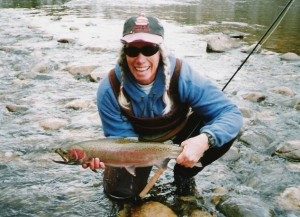
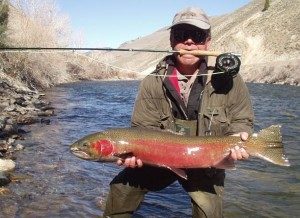
This dam on the Snake River is 45 minutes south of Boise and located in the Birds Of Prey National Conservation Area. The river below the dam is home to a very healthy population of smallmouth bass, channel catfish, carp, crappie, and the occasional rainbow trout. Bass are the usual targets and are easily fooled with most streamer-type patterns such as woolly buggers and zonkers. Catches of forty or more smallmouth in a summer evening are not uncommon, with an occasional rainbow or channel catfish keeping things interesting. Fishing is done primarily from the bank, with some early season fishing for smallmouth bass by boat
Non-fisherman can enjoy the rugged beauty of this area with its breathtaking overlooks along the canyon rim and numerous great hiking trails along the sheer rock faces below the canyon walls. Bird-watchers will marvel at sightings of Prairie and Peregrine Falcons, Merlin, various hawks, Golden and Bald Eagles, and several species of owls.
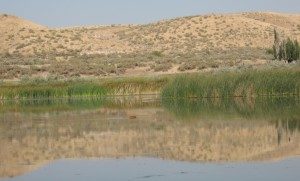
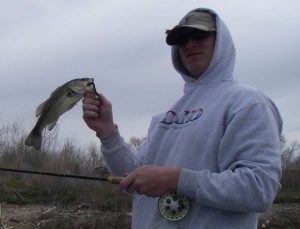
This dam on the Snake River is 45 minutes south of Boise and located in the Birds Of Prey National Conservation Area. The river below the dam is home to a very healthy population of smallmouth bass, channel catfish, carp, crappie, and the occasional rainbow trout. Bass are the usual targets and are easily fooled with most streamer-type patterns such as woolly buggers and zonkers. Catches of forty or more smallmouth in a summer evening are not uncommon, with an occasional rainbow or channel catfish keeping things interesting. Fishing is done primarily from the bank, with some early season fishing for smallmouth bass by boat
Non-fisherman can enjoy the rugged beauty of this area with its breathtaking overlooks along the canyon rim and numerous great hiking trails along the sheer rock faces below the canyon walls. Bird-watchers will marvel at sightings of Prairie and Peregrine Falcons, Merlin, various hawks, Golden and Bald Eagles, and several species of owls.


The McCall area, located on Payette Lake two hours north of Boise, has long been a favorite recreation and vacation area for southern Idaho. It is surrounded by the beautiful Payette National Forest where more than 200 lakes and reservoirs, large rivers, and bountiful streams offer anglers countless opportunities to fish and hike, often in complete solitude.
The McCall fishing season starts in May on local reservoirs and rivers for trout. After the early summer runoff, streams and rivers provide plentiful fishing for rainbow, cutthroat, and brook trout. In late summer, fishing moves to the mountain lakes, where a reliable Cinnamon Ant hatch in early September produces some of the finest dry fly fishing available anywhere.
The area also boasts extraordinary smallmouth bass fishing on Little Payette Lake and the Lower Salmon River.
While October offers fine trout fishing throughout the region, most anglers are focusing on steelhead fly-fishing on the Lower Salmon River in nearby Riggins (45 minutes drive from McCall).

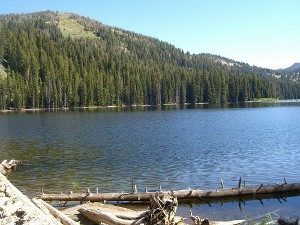
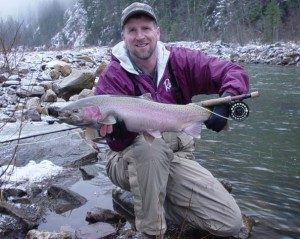 The Lower Salmon River Area around Riggins (three hours from Boise, and one hour northwest of McCall) is primarily a fall steelhead fishery, although it can offer a short spring Chinook season in early June and very good small mouth bass fishing through the heat of the summer.
The Lower Salmon River Area around Riggins (three hours from Boise, and one hour northwest of McCall) is primarily a fall steelhead fishery, although it can offer a short spring Chinook season in early June and very good small mouth bass fishing through the heat of the summer.
Steelhead move into the lower Salmon River in mid-September as summertime water temperatures cool and provide increasingly exciting fly fishing opportunities until mid-November when the water temps drop into the high 30s. Early season fishing focuses on skating dry flies or swinging traditional wet flies and Spey-style flies, while late season steelhead fishing (which can go into December, weather permitting) relies on sinking tip lines and leech patterns. Fish average 5-10 pounds, with larger fish (12-18 lbs) caught regularly each season. If you are new to steelhead fishing or to the Salmon River, it may be best to initially fish with an experienced guide.
Increasingly, anglers on the Salmon River are using Spey rods to fly fish for steelhead. We’ve been Spey fishing since 1998 and offer spring and fall Spey casting classes.
The Lower Salmon River is reached by taking Hwy 55 North from Boise to McCall, then traveling northwest to Riggins. Hotel and restaurant services occur in and around Riggins. Road access along the river above and below Riggins is good; however many anglers use drift boats or jet boat to access their favorite holes.
This exceptional river provides an ever popular fishery in the beautiful Wood River Valley about 2 1/2 hours east of Boise. Home to a healthy population of rainbows throughout, as well as a few browns below the town of Bellevue. Anglers often find eager trout that offer a nice respite from the finicky trout of nearby Silver Creek. Indeed, the Big Wood is often the “ace in the hole” when conditions are less than ideal on other area waters.
Considered a freestone river, it is host to an impressive summer hatch season as well as a great midge fishery in the winter time. In fact, it is considered to be one of the best winter fisheries around.
During heavy water years, the Big Wood River may not be very fishable until almost July. When it is fishable, there is almost always a hatch occurring. Caddis hatches on this river can be impressive. There are also stoneflies and various mayfly hatches.
For the angler that wants to spend a couple of days in this beautiful area, a wide range of lodging and dining accommodations can be found in Bellevue, Hailey and Ketchum. Day trips can be made to the Little Wood, Silver Creek, Big Lost River, and Salmon River in the Stanley area, and many more areas of interest.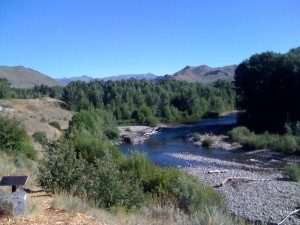
 MOUNTAIN VIEW RESERVOIR
MOUNTAIN VIEW RESERVOIR
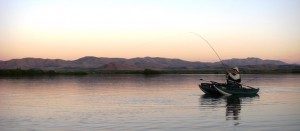 LAKE BILLY SHAW
LAKE BILLY SHAW
Opened in 2001, this reservoir is managed for trophy rainbow trout. Fished both from a boat and by wading, it provides good fishing for rainbows averaging 18 inches and some exceeding 5 pounds. This fishery is expected to improve as time goes by.
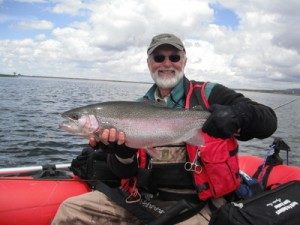 SHEEP CREEK RESERVOIR
SHEEP CREEK RESERVOIR
The largest reservoir in Duck Valley, the usually turbid water conceals a rich aquatic soup of insects and bait fish. Large bays and smaller coves of extensive weed beds, with open channels winding through them, provide perfect cruising lanes for trout and places for the angler to intercept them. At nearly 800 acres, when full, this reservoir is best fished from a float tube or a boat that can be taken in shallow water.
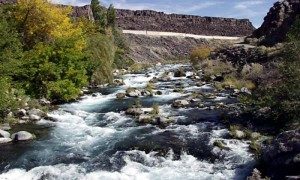 MALAD RIVER
MALAD RIVER
Formed at the confluence of the Big and Little Wood rivers near Gooding, this 12 mile long river can be very productive for both brown and rainbow trout. The Malad, from the I-84 bridge upstream to its source, is open to fishing year round and can be a surprisingly good dry fly fishery even in the dead of winter. Below the bridge, fishing is not recommended until shortly before it enters the Snake River due to the 250-foot deep gorge the river crashes through. South of the gorge, pocket water fishing can be excellent for rainbows that can reach 20 inches.
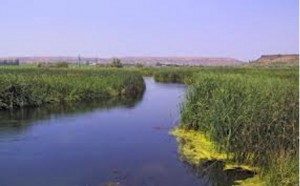 BILLINGSLEY CREEK
BILLINGSLEY CREEK
Located near the town of Hagerman, this spring creek is best accessed from the new Billingsley Creek State Park. There isn’t a lot of bank access here, so a float tube or canoe will open up many opportunities for the angler. Browns and rainbows are available in this spring creek and can range in size from 10″ to 20″ , with the occasional fish over 20″ prowling these waters. The creek also holds many golden-colored rainbows, a color variant of rainbow trout that are highly visible and exciting to fish for.
